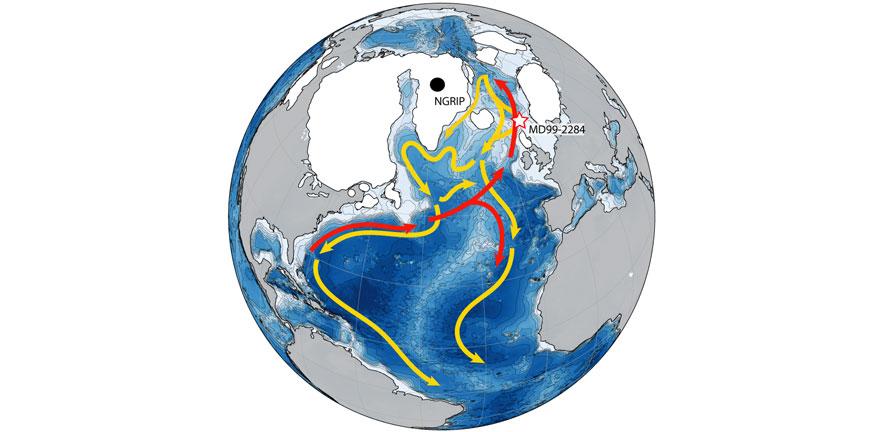
A new study is the first to measure the time lags between changing ocean currents and major climate shifts.
A new study is the first to measure the time lags between changing ocean currents and major climate shifts.
There are clear climate precursors provided by the ocean state — like warning signs, so to speak
Francesco Muschitiello
In the Atlantic Ocean, a giant ‘conveyor belt’ carries warm waters from the tropics into the North Atlantic, where they cool and sink and then return southwards in the deep ocean. This circulation pattern is known as the Atlantic Meridional Overturning Circulation (AMOC) and it’s an important player in the global climate, regulating weather patterns in the Arctic, Europe, and around the world.
Evidence increasingly suggests that this oceanic current system is slowing down, and some scientists fear it could have major effects, such as causing temperatures to dive in Europe and warming the waters off the eastern coast of the USA, potentially harming fisheries and exacerbating hurricanes.
A new study published in Nature Communications provides insight into how quickly these changes could take effect if the ocean current system continues weakening.
An international team of scientists studied one of the key sections of the AMOC –where North Atlantic water sinks from the surface to the bottom of the ocean. They confirmed that changes in the ocean conveyor belt preceded abrupt and major climatic changes during the transition out of the last ice age, referred to as the last deglaciation. The study is the first to determine the time lags between past changes to the AMOC and major climate changes.
“Our reconstructions indicate that there are clear climate precursors provided by the ocean state — like warning signs, so to speak,” said lead author Francesco Muschitiello from the University of Cambridge’s Department of Geography, who completed the work while a postdoc at Columbia University.
Until now, it has been difficult to resolve whether past changes in the ocean conveyor belt occurred before or after the abrupt climate shifts that punctuated the last deglaciation in the Northern Hemisphere. To overcome the usual challenges, the team pieced together data from a sediment core drilled from the bottom of the Nordic Seas, a lake sediment core from southern Scandinavia, and ice cores from Greenland.
Scientists typically rely on radioactive carbon (carbon 14) dating to determine the ages of sediments. This relationship is tricky in ocean sediments, though, because carbon 14 is created in the atmosphere, and it takes time for the carbon to make its way through the ocean. By the time it reaches the organisms at the bottom of the water column, the carbon 14 could already be hundreds or thousands of years old. So the team needed a different way to date the sediment layers in the marine core.
The researchers solved this puzzle by measuring carbon 14 levels from a nearby lake sediment core and matching it to the marine core layers. Next, they compared the real age of the marine sediments to the deep ocean carbon 14 measurement, giving them a record of ocean circulation patterns in this region over time. The final piece of the puzzle was to analyse ice cores from Greenland, to study changes in temperature and climate over the same time period.
Comparing the data from the three cores revealed that the AMOC weakened in the time leading up to the planet’s last major cold snap around 13,000 years ago. The ocean circulation began slowing down about 400 years before the cold snap, but once the climate started changing, temperatures over Greenland plunged quickly by about 6 degrees.
A similar pattern emerged near the end of that cold snap, transitioning out of the ice age; the current started strengthening roughly 400 years before the atmosphere began to heat up dramatically, when Greenland warmed up rapidly — its average temperature climbed by about 8 degrees over just a few decades, causing glaciers to melt and sea ice to drop off considerably in the North Atlantic.
For now it’s not fully clear why there was such a long delay between the AMOC changes and climatic changes over the North Atlantic.
It’s also difficult to pinpoint what these patterns from the past could signify for Earth’s future. Recent evidence suggests that the AMOC began weakening again 150 years ago. However, current conditions are quite different from the last time around, says Muschitiello: the global thermostat was much lower back then, winter sea ice stretched farther south than New York Harbour, and the ocean structure would have been much different. In addition, the past weakening of the AMOC was much more dramatic than today’s trend so far.
“It is clear that there are some precursors in the ocean, so we should be watching the ocean. The mere fact that AMOC has been slowing down, that should be a concern based on what we have found,” said Muschitiello.
The study should also help to improve the physics behind climate models, which generally assume the climate alters abruptly at the same time as AMOC intensity changes. The model refinements, in turn, could make climate predictions more accurate. As Svensson puts it: “As long as we do not understand the climate of the past, it is very difficult to constrain the climate models needed to make realistic future scenarios.”
Reference:
Francesco Muschitiello et al. 'Deep-water circulation changes lead North Atlantic climate during deglaciation.' Nature Communications (2019). DOI: 10.1038/s41467-019-09237-3
Adapted from Columbia University story.
A bold response to the world’s greatest challenge
The University of Cambridge is building on its existing research and launching an ambitious new environment and climate change initiative. Cambridge Zero is not just about developing greener technologies. It will harness the full power of the University’s research and policy expertise, developing solutions that work for our lives, our society and our biosphere.

The text in this work is licensed under a Creative Commons Attribution 4.0 International License. Images, including our videos, are Copyright ©University of Cambridge and licensors/contributors as identified. All rights reserved. We make our image and video content available in a number of ways – as here, on our main website under its Terms and conditions, and on a range of channels including social media that permit your use and sharing of our content under their respective Terms.




